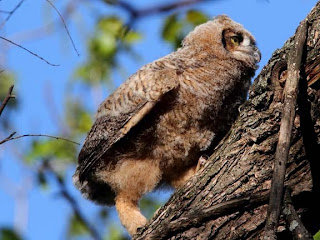The great horned owl is one of the first bird species to nest each year. They are often on the nest beginning at the end of January. Great horns do not make a nest, they borrow a nest from another bird that has not yet returned from their winter migration. Typically they will use a nest from another large bird such as a hawk, heron or crows. They may also use a tree hollow or a squirrel's nest, if they are desperate. Clutch sizes vary from 1 to 4 eggs. The female incubates the eggs which take 4 to 5 weeks to hatch. The female continues to sit on the nest after the eggs hatch to keep the bald and helpless chicks warm. As the chicks grow and are able to keep themselves warm the female will join the male in hunting for the family laving the chicks alone. At around 5 weeks of age the chicks begin to get adventurous and start branching, climbing along the tree branches of the nesting tree. It is not unusual that a chick may fall out of the tree at this age. The parents will continue to watch over and feed the chick on the ground until the chick can climb back up into the tree. Unfortunately this is when people often find the chick on the ground. Often they will take the chick home, usually out of concern, but they are not a good substitute for the chicks real parent and during this developmental stage of the chicks life they can really mess them up. It is called human imprinting and it usually leads to an owl that can no longer survive on their own in the wild. SO what should you do if you find a chick? If the chick does not appear injured or in danger the best thing to do is leave it for its parents to care for. If it looks like the chick is hurt or in danger, especially from domestic cats or dogs, then you should take it to a facility that cares for injured raptors or birds.
Sunday, September 8, 2013
Great Horned Owl
The great horned owl is the top raptor predator where I live. These efficient hunters are considered a border species because they nest and live in a wooded area that is usually adjacent to an open area that is used for hunting. They eat a variety of prey including rabbits, squirrels, rodents, frogs, skunks, and birds. They are crepuscular which means most of their hunting occurs around dusk or dawn. Their large eyes have many rods which are cells that assist in seeing things in black and white. The rods help them to see in very low light. The facial disks, flat spots, on their face help to direct sound to their ears, which are on the side of their face underneath the feathers. The ears are at different heights allowing the owl to use asynchronous hearing to locate their prey by sound. This is especially helpful when the owl is hunting prey that is burrowing under the snow, which happens often here in Minnesota during the winter.
Subscribe to:
Post Comments (Atom)





7 comments:
Wonderful post and fantastic owl shots ~ carol ^_^
Beautiful bird!
Fantastic shots and I love the great horned.
Magnificent birds.
Love the shot of the young one climbing the tree.
Great advice for people re chicks on ground. Taking one home is never a good idea, and a raptor or bird facility can best deal with injuries.
K
...it's fabulous to see the youngster horned owl
Beautiful images of this wonderful Owl and great information shared!
Sorry for my tardiness. Monday my bad knee gave way to a full Medial Meniscus tear and I am having Arthroscope done to help ease pain this Tuesday...doing life ;)
Post a Comment